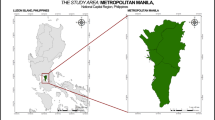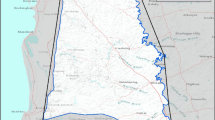Abstract
A method enabling the object-oriented image analysis of landscape elements incorporating topographic data was designed and tested on a Japanese countryside target area. IKONOS data (four multispectral bands with a spatial resolution of 4 m and a panchromatic band with a spatial resolution of 1 m) acquired on 23 April 2001 were used. Definiens v.5 software (Definiens AG, München, Germany) was employed for the classification. The initial segmentation was multiresolution and bottom-up, and each segment identified was considered to be one object. Two classifications employing the same landscape elements and ground truth data were implemented. One classification adopted an object-based image analysis classification method based on spectral characteristics; the other utilized an object-oriented image analysis (OOIA) that allows for a suitable scale parameter to be selected independently for each landscape element. In addition, topographic data derived from field surveys (walking surveys) and topographic maps were used to create a topographic database delineating the boundary between valley bottoms and the adjacent slopes (elevation: about 10 m). These data were then integrated into the OOIA analysis. The accuracies of the two classifications were assessed by comparing the results to a master landscape map produced directly from aerial photographs and on-site observations. The object-oriented method using the topographic data resulted in a higher overall kappa coefficients (0.63–0.47) than the object-based method. These results indicate that object-oriented image analysis of very high resolution data used in combination with topographic data can be an effective tool for landscape classification in Japan, where historical land-use patterns have resulted in finely dissected landscapes.










Similar content being viewed by others
References
Allen TFH, Starr TB (1982) Hierarchy: perspectives for ecological complexity. University of Chicago Press, Chicago
Baatz M, Schäpe A (2000) Multiresolution segmentation: an optimization approach for high quality multi-scale image segmentation. In: Strobl J, Blaschke T (eds) Angewandte Geographische Informations Verarbeitung XII. Wichmann-Verlag, Heidelberg, pp 12–23
Baatz M, Hoffmann C, Willhauck G (2008) Progressing from object-based to object-oriented image analysis. Object-based image analysis spatial concepts for knowledge-driven remote sensing applications. Springer, New York, pp 29–42
Burnett C, Blaschke T (2003) A multi-scale segmentation/object relationship modelling methodology for landscape analysis. Ecol Model 168:233–249
De Laet V, Paulissen E, Meuleman K, Waelkens M (2009) Effects of image characteristics on the identification and extraction of archaeological features from Ikonos-2 and QuickBird-2 imagery, case study: Sagalassos (southwest Turkey). Int J Remote Sens 30:5655–5668
Definiens AG (2006) Definiens Professional 5 user guide. Definiens AG, Munich
Fujihara M, Hara K, Short KM (2005) Changes in landscape structure of “yatsu” valleys: a typical Japanese urban fringe landscape. Landsc Urban Plan 70:261–270
Groom G, Mücher CA, Ihse M, Wrbka T (2006) Remote sensing in landscape ecology: experiences and perspectives in a European context. Landsc Ecol 21:391–408
Hall O, Hay GJ, Bouchard A, Marceau DJ (2004) Detecting dominant landscape objects through multiple scales: an integration of object-specific methods and watershed segmentation. Landsc Ecol 19:59–76
Hara K, Kamagata N, Ishitsuka T, Tomita M (2007) Object-based classification of rural landscapes using remotely sensed data of various resolutions. In: Proc 7th IALE World Congr, Wageningen, The Netherlands, 8–12 July 2012, Pt 2, p 642
Herold M, Goldstein NC, Clarke KC (2003) The spatiotemporal form of urban growth: measurement, analysis and modeling. Remote Sens Environ 86:286–302
Johansen K, Coops NC, Gergel SE, Stange Y (2007) Application of high spatial resolution satellite imagery for riparian and forest ecosystem classification. Remote Sens Environ 110:29–44
Kamagata N, Hara K, Mori M, Akamatsu Y, Li Y, Hoshino Y (2006) A new method of vegetation mapping by object-based classification using high resolution satellite data. J Jpn Soc Photogramm Remote Sens 45:43–49 (in Japanese with English abstract)
Kamagata N, Hara K, Mori M, Akamatsu Y, Li Y, Hoshino Y (2008) Object-based classification of IKONOS data for vegetation mapping in Central Japan. Object-based image analysis spatial concepts for knowledge-driven remote sensing applications. Springer, New York, pp 459–476
Murakami T, Onishi N, Kajisa T, Mizoue N, Yoshida S (2010) Examination of the optimum segmentation in the object-based image analysis for forest stand type classification. J Jpn Soc Photogramm Remote Sens 49:159–165 (in Japanese with English abstract)
Nakamura T, Short KM (2001) Land-use planning and distribution of threatened wildlife in a city of Japan. Landsc Urban Plan 53:1–15
O’Neill RV, DeAngelis DL, Waide JB, Allen TFH (1986) A hierarchical concept of ecosystems. Princeton University Press, Princeton
Shao G, Wu J (2008) On the accuracy of landscape pattern analysis using remote sensing data. Landsc Ecol 23:505–511
Urban DL, O’Neill RV, Shugart HH Jr (1987) Landscape ecology: a hierarchical perspective can help scientists understand spatial patterns. Bioscience 37:119–127
Wang L, Sousa WP, Gong P (2004) Integration of object-based and pixel-based classification for mapping mangroves with IKONOS imagery. Int J Remote Sens 25:5655–5668
Wu J (1999) Hierarchy and scaling: extrapolating information along a scaling ladder. Can J Remote Sens 25:367–380
Wu J, David JL (2002) A spatially explicit hierarchical approach to modeling complex ecological systems: theory and applications. Ecol Model 153:7–26
Yan G, Mas JF, Maathuis BHP, Xiangmin Z, Van Dijk PM (2006) Comparison of pixel-based and object-oriented image classification approaches—a case study in a coal fire area, Wuda, Inner Mongolia, China. Int J Remote Sens 27:4039–4055
Yu Q, Gong P, Clinton N, Biging G, Kelly M, Schirokauer D (2006) Object-based detailed vegetation classification with airborne high spatial resolution remote sensing imagery. Photogramm Eng Remote Sens 72:799–811
Acknowledgments
The authors would like to thank Professor Kevin M. Short of TUIS for helping to improve the English used in this work. This research was funded in part by the MEXT-Supported Program for the Strategic Research Foundation at Private Universities from 2008-2012 (S0801024).
Author information
Authors and Affiliations
Corresponding author
Rights and permissions
About this article
Cite this article
Takahashi, K., Kamagata, N. & Hara, K. Object-oriented image analysis to extract landscape elements in urban fringes, Central Japan. Landscape Ecol Eng 9, 239–247 (2013). https://doi.org/10.1007/s11355-012-0202-7
Received:
Revised:
Accepted:
Published:
Issue Date:
DOI: https://doi.org/10.1007/s11355-012-0202-7




